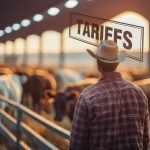For the week ending March 22, Western Canadian feeder cattle markets traded steady to $5 higher on average. Higher quality strings under 600 pounds traded $5 to as much as $10 higher in some cases but the lighter weight categories were quite variable across the Prairies.

Klassen: Feeder cattle follow live cattle futures higher

Report tracks pasture loss in Canada
Forage industry says there are ways to claw pasture and grassland back, while also protecting farm profit
Reading Time: 5 minutes Pasture acreage has been dropping in Canada. Here’s why, and what can be done about it.

Klassen: Tariff drama results in volatile feeder cattle market
For the week ending March 7, there were two distinct price structures. On Monday, March 3, feeder cattle prices were relatively unchanged from the previous week. However, once the U.S. implemented tariffs for Canadian cattle on March 4 , feeder cattle markets dropped by $10-$15/cwt on average.

Klassen: Feeders remain firm despite tariff uncertainty
For the week ending March 1, Western Canadian feeder markets traded steady to $6 higher compared to seven days earlier. Despite expected tariffs, there was no fear to secure ownership.

Canadian beef pitches mutual case against tariffs to U.S. counterparts
Canadian beef may be finding a sympathetic ear with U.S. trading partners who also have no interest in a trade war, but will that be enough to sway the Trump administration away from their threatened tariffs?
Reading Time: 7 minutes Canadian beef producers face uncertainty as potential US tariffs loom. Despite efforts at a US conference, the industry remains unclear on the future impact. Learn how producers are navigating this challenging trade situation.

Klassen: Feedlot operators anticipate lower feeder cattle supplies for spring
Feedlot Operators Anticipate Lower Feeder Cattle Supplies in Spring
For the week ending February 22, Western Canadian feeder cattle markets traded steady to $5 higher on average compared to seven days earlier. Positive feeding margins along with improving weather enhanced demand from Alberta and Ontario feedlot operators. Many feedlot operators have shrugged off the tariff threat and are carrying on business as normal. Auction market scouts, who are sourcing for cattle, report that many cow calf producers sold cattle earlier in December or January. It appears that there will be a sharp drop in available numbers in Western Canada during March and April. This sentiment appears to have spurred on larger operations to secure ownership of feeder cattle in the short-term
At the Lloydminster sale, larger frame lower flesh Simmental based steers weighing 950 pounds sold for $363. South of Edmonton, larger frame mixed steers on barley and corn silage ration with full processing records averaging 903 pounds traded for $370. North of Calgary, Limousin mixed heifers carrying lighter butter averaging 910 pounds supposedly traded for $335.
At the St Rose Auction in Manitoba, medium to larger frame red steers evaluated at 800 pounds notched the board at $395. At the same sale, larger frame black heifers on the card at 809 pounds were valued at $357. The Prince Alberta auction market report had black steers weighing 742 pounds trading for $400. In Central Alberta, a smaller string of 705-pounds Angus blended steers on light barley and silage diet with full processing data were last bid at $432. In Southern Alberta, red Simmental based heifers averaging a hair over 700 pounds reportedly moved at $374.
The Lloydminster Auction Market Report had black mixed steers evaluated at 604 pounds selling for $486. In central Saskatchewan, run-of-the-mill mixed heifers scaled at 610 pounds apparently sold for $408. In Manitoba, Simmental cross steers weighing a hair over 600 pounds were quoted at $479. In central Alberta, pre-conditioned Charolais heifers weighing 625 pounds on hay and silage diet were valued at $433.
The Prince Albert Market Report had 500-pound black steers selling for $560. In southern Alberta, Charolais based steers averaging 510 pounds were quoted at $570. In Manitoba, a smaller package of Charolais heifers weighing 505 pounds reportedly sold for $469.
U.S. feedlot placements during January were 1.822 million head, up 2% or 31,000 head from the January 2024 figure of 1.791 million. In the U.S., we’re seeing a build-up of market-ready fed cattle supplies. The opposite is occurring in Western Canada. Market-ready fed cattle supplies in Alberta and Saskatchewan are extremely tight. The function of the Western Canadian feeder cattle market is to ration demand by trading at a premium to U.S. values.
It appears that there will be a sharp drop in available numbers in Western Canada during March and April. This sentiment appears to have spurred on larger operations to secure ownership of feeder cattle in the short-term.

Canadian beef exports expected to set record
Canada Beef outlines the top international markets where products were shipped around the world in the previous year
Reading Time: 3 minutes Canada is expected to set a record year for beef export value in 2024. 2022 was a record and 2024 will behigher at more than $7 billion.

Alberta Beef Producers work towards being fully funded
Alberta Beef Producers sees non-refundable checkoff as long-term goal, but says it will take a cautious approach
Reading Time: 4 minutes Alberta Beef Producers hope to work towards becoming a fully-funded industry, which would mean making checkoff dollars non-refundable. Brad Dubeau, Alberta Beef Producers general manager, said they will take their time getting there, but it is a priority.

Klassen: Feeder market recovers on strong demand
For the week ending February 15, Western Canadian feeder cattle markets traded steady to five dollars higher on average compared to seven days earlier. The market has recovered after the recent stretch of adverse weather and the U.S. tariff threat in early February.

Canadian Beef Advisors unveil five-year national strategy
The new 2025-2030 national beef strategy includes trade challenges, sustainability and global opportunities for Canadian beef
Reading Time: 3 minutes The new 2025-2030 national beef strategy includes trade challenges, sustainability and global opportunities for Canadian beef.

